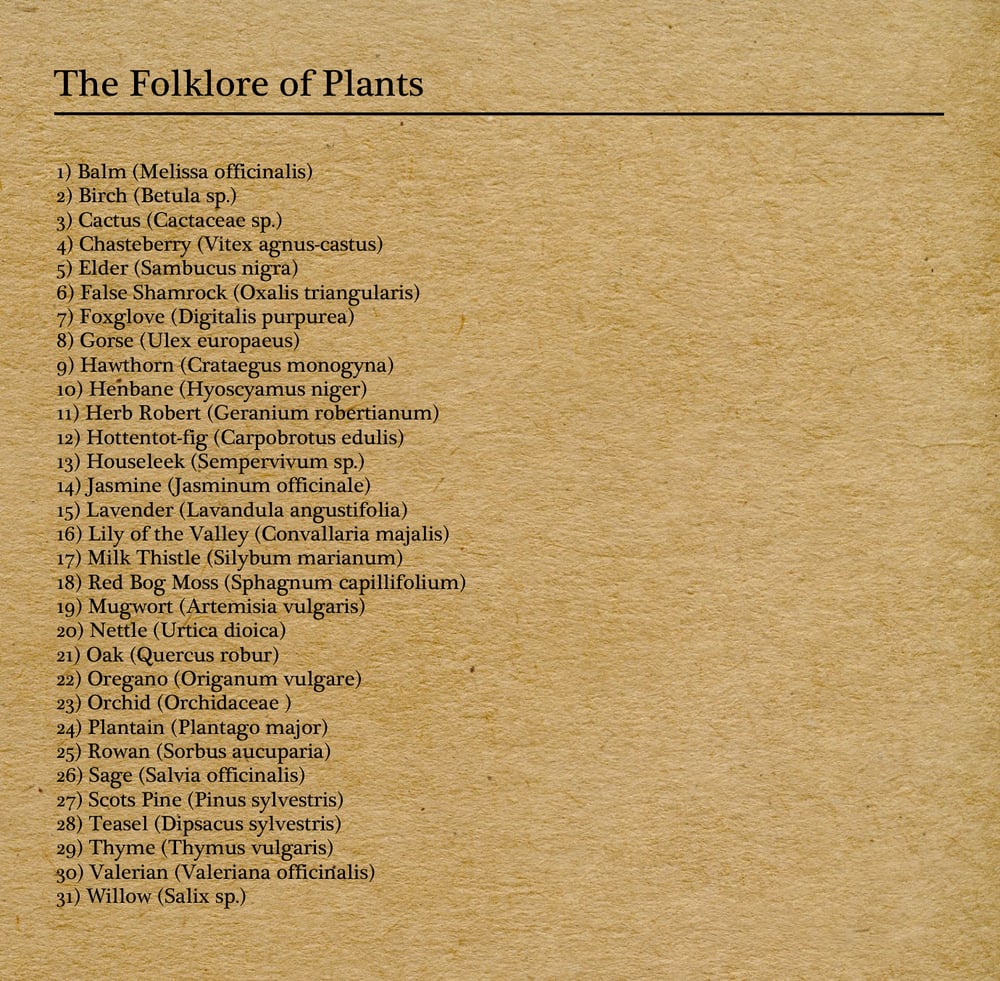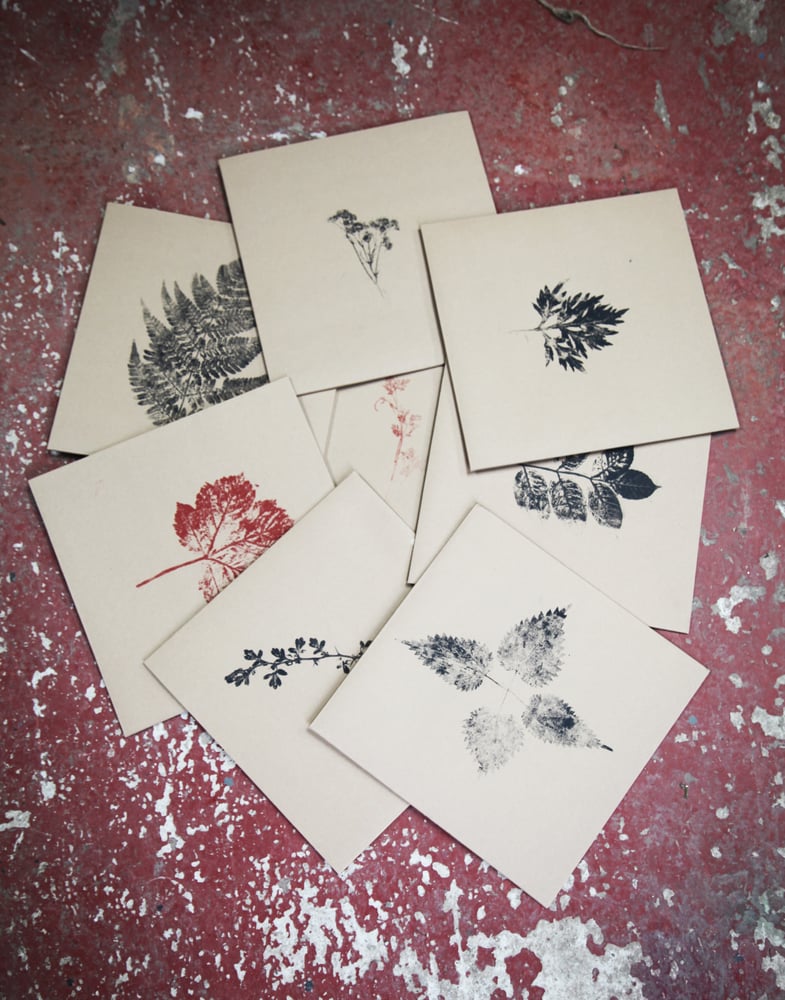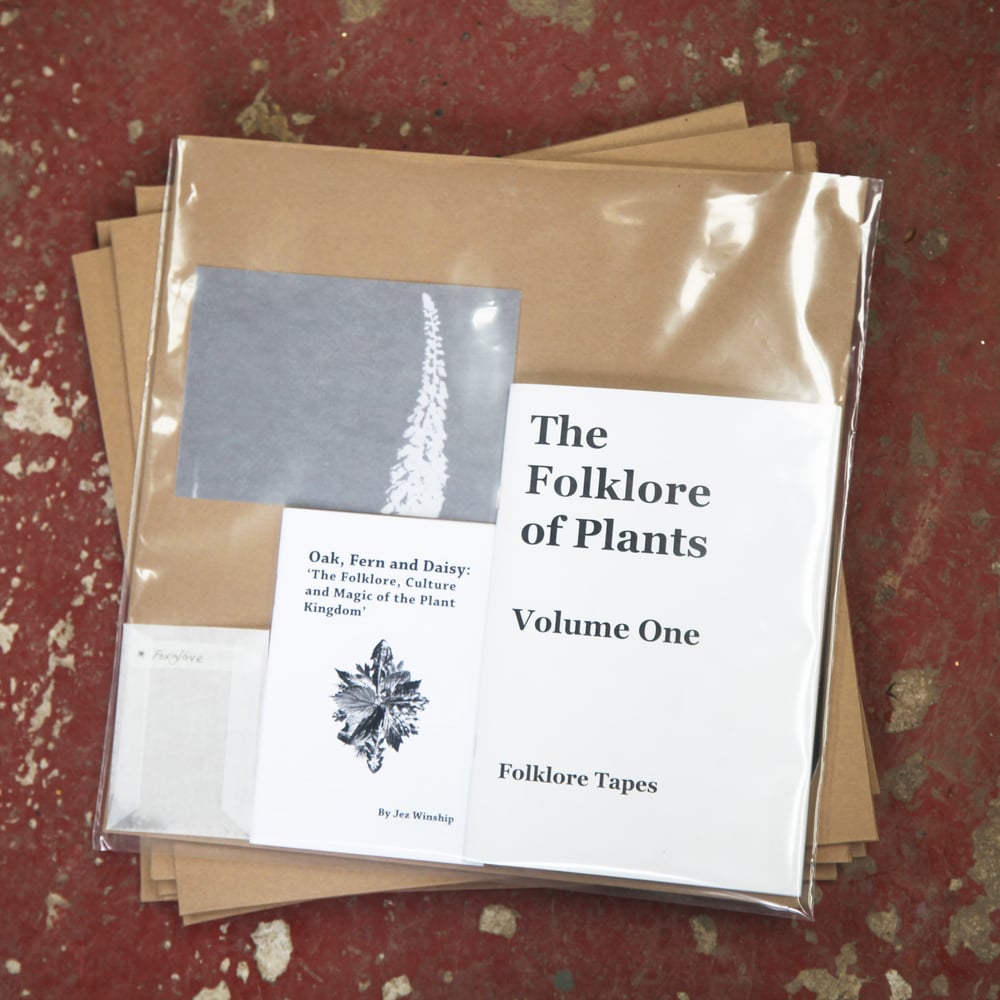The Folklore of Plants Vol.I
£20.00
• Researched and executed by 31x artists
• Thirty-one track twelve-inch vinyl and download code.
• Fourty page A5 pamphlet includes plantlore and illustrations from artists and herbal medicine section by herbalist Zoe Naylor.
• Twenty eight page pocket A6 booklet Oak, Fern and Daisy: ‘The Folklore, Culture and Magic of the Plant Kingdom’ By Jez Winship.
• Link to the 16mm film 'Pattern of Light' by Mary and David
• All contents housed within a unique plant relief printed hand numbered manilla sleeve
• Contains seed envelope harvested by FT group.
1) t/e/u/ - Balm (Melissa officinalis)
2) The Silver Funz - Birch (Betula sp.)
3) Joshua Bonnetta - Cactus (Cactaceae sp.)
4) Kelly Jayne Jones - Chasteberry (Vitex agnus-castus)
5) David Chatton Barker - Elder (Sambucus nigra)
6) James Green - False Shamrock (Oxalis triangularis)
7) Arianne Churchman - Foxglove (Digitalis purpurea)
8) Paper Dollhouse - Gorse (Ulex europaeus)
9) Belbury Poly - Hawthorn (Crataegus monogyna)
10) Sam McLoughlin - Henbane (Hyoscyamus niger)
11) Carl Turney & Brian Campbell - Herb Robert (Geranium robertianum)
12) David Jaycock - Hottentot-fig (Carpobrotus edulis)
13) Stu Bannister - Houseleek (Sempervivum sp.)
14) Hugh Metcalfe - Jasmine (Jasminum officinale)
15) Mary Stark - Lavender (Lavandula angustifolia)
16) Delphine Dora - Lily of the Valley (Convallaria majalis)
17) Sally Golding - Milk Thistle (Silybum marianum)
18) Ian Humberstone - Red Bog Moss (Sphagnum capillifolium)
19) Magpahi - Mugwort (Artemisia vulgaris)
20) Zoe Naylor - Nettle (Urtica dioica)
21) Hannah Leighton Boyce - Oak (Quercus robur)
22) Joe Duddell - Oregano (Origanum vulgare)
23) Xian Orphic - Orchid (Orchidaceae )
24) Steve Patterson - Plantain (Plantago major)
25) Mary & David - Rowan (Sorbus aucuparia)
26) Bridget Hayden - Sage (Salvia officinalis)
27) Modern Studies - Scots Pine (Pinus sylvestris)
28) Alice Hartley - Teasel (Dipsacus sylvestris)
29) Jennifer Reid - Thyme (Thymus vulgaris)
30) Dean McPhee - Valerian (Valeriana officinalis)
31) Eva Bowen - Willow (Salix sp.)
An extract from Oak, Fern and Daisy: ‘The Folklore, Culture and Magic of the Plant Kingdom’ By Jez Winship.
Flora Britannica, the matter of Britain. This island’s plants clothe the landscape, characterising the country, lending it colour, scent and texture. They also colour the human imagination, suffusing it with a heady pharmacopoeia of mythic legends, local tales and magical lore. The lore and legends which gathered around certain plants reflected their manifold uses and associations, sometimes even the emotional resonance they exuded. Good or ill fortune could arise from the same species depending on the manner of its usage; the customs and folk wisdom attached to it served to attract the former and avoid the latter.
Magical properties were ascribed to particular plants, often betokening an Understanding of their inherently beneficial qualities. Breaks or ruptures (bone fractures or hernias) in children could be healed by passing them through the rift in a young ash, split apart for the purpose. The tree would then be bound together. If it fused together once more, the child would also be made whole.
The time of harvesting could be all-important to maximising magical potency and midsummer’s eve and day were particularly propitious moments for the collection of an enchanted floristry. St John’s Wort was well-renowned for its general efficaciousness in combating the maledictions of witches and spirits, hence its common name ‘scaredevil’. Its effect would be highly concentrated if it were picked on midsummer’s eve, ideally whilst the dew still jewelled its leaves. As if they realised the danger faced at this particular time of the year, it was said that the plants were ambulatory, confusing would-be herbalists by migrating from their original patch.
Other plants had more generally curative properties. Yarrow was the equivalent of an annual prophylactic jab if picked and hung up in the house on midsummer’s eve. It would protect against all disease for the coming year. One widespread ritual cure involved training naturally occurring blackberry arches so that each end was rooted in the ground. The thorned gateway would offer a curative passage to children and cattle, who would pass through from the east into the west, treading or crawling a solar path.
The rank or poisonous qualities of some plants lent them an association with witches, demons or even with their master, the Devil himself. Nightshade, with or without the ‘deadly’ prefix, was well-known to be poisonous and this, combined with its midnight black berries and bruise-purple flowers, led to it being inextricably linked with witches and witchcraft. It was used in cauldron decoctions for spells aimed at quickening madness or summoning death, a recognition of both the poisonous and psychoactive components of its biochemistry.
Perhaps because of their own transient blooming, their brief summer span, flowers provided plentiful portents of incipient mortality. There were many blooms which were not to be brought into the house. Hawthorn, the blossom with the stench of decay, was principal amongst them. Bring it indoors and your mother will die, children were solemnly warned. Anxious parents, on the other hand, thought it would betoken the death of a child. Midlanders, meanwhile, muttered the following cheery couplet on the occasion of the hazel producing its annual autumn crop: ‘many nuts, many pits’. In Scotland, the Foxglove was known as ‘Dead Man’s Bells’. If you heard their tinkling fairy tintinnabulation it was time to set your affairs in order.
Plants could also be associated with life, fertility and fecundity. Mistletoe was one such, its flourishing amongst skeletal branches in the midst of winter bearing the promise of renewal. The white berries are like glistening drops of semen, and when squeezed ejaculate a sticky, seedy white juice. Cuckoo pint is another highly suggestive plant, its proudly priapic purple pollinating member hooded within a vulval green cowl. Commonly known as lords and ladies, it has accumulated a whole lexicon of nudge nudge nicknames: Adam and Eve, naked girls, naked boys, bobbins and Joan, Jack in the pulpit, devils and angels, cows and bulls, wake robin, the Devil’s man and woman and Jack in the green. Unsurprisingly, it was thought to have aphrodisiac qualities.
We have long since discarded the superstitious and sympathetic beliefs which betokened our intimate connection with the natural world. What plant lore and symbolic language might serve for the modern day, I wonder. Perhaps it is time to adapt the old beliefs, to create new enchantments, cures for the psychic depredations and protections against the malevolent forces of the digital age of distraction and confusion, of occult economics and demagogic magi. To infuse the world with powerful and potent magic once more.
The Folklore of Plants - Trailer from David Chatton Barker on Vimeo.





